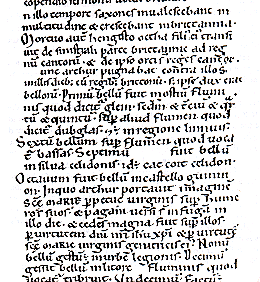King Arthur: Birth of a Legend Part 3: Monks and More MonksAnother monk, who wrote a century later, was named Nennius. He wrote something called Historia Brittonum, or The History of the Kings of Britain. Nennius is thought to have lived in Wales, in Powys. He is thought to have written the Historia Brittonum in the first half of the 9th Century. Many historians date it at 830. 
Nennius goes way back in history, with his version of the Bible, naming famous people and events, such as Adam and Eve and the Great Flood and the Exodus and then, of course, the ministry of Jesus. He names some famous Romans, from Caesar to Constantine. Then, he settles in for a bit of geography. He names 33 cities in Britain. He names a few rivers. He talks about the Scots and the Picts and the Irish and the Britons. Early on, he identifies the problem that he later has Vortigern try to solve: "The Britons who, suspecting no hostilities, were unprovided with the means of defense, were unanimously and incessantly attacked, both by the Scots from the west, and by the Picts from the north." And then he has this to say: "A long interval after this, the Romans obtained the empire of the world." The narrative then moves to Vortigern, who styled himself high-king and invited the Anglo-Saxon leaders Hengist and Horsa to England to help fight off that invasion from the north. In the middle of his narrative, Nennius is suddenly bursting with details about Arthur. He's not a king, he's a battle commander, a dux bellorum, as the Latin would have it. And he wins 12 significant 12 battles, including the climactic Battle of Badon Hill. Nennius describes these battles, rather than giving specifics. This list of generalities has fascinated scholars for many, many years because some of these places just aren't where they should be, or they aren't where Nennius says they were, or they can't be found. The ones that have been identified paint a picture of the Britons fighting all over the British Isles – north, south, east, and west. So if Arthur was the dux bellorum in all 12 of these battles, he really got around. Historians tend to take Nennius's writings with a bit of restraint. He was writing of events that occurred a few hundred years before he was. He was also a monk who couldn't resist inserting religious references into his writing while also assigning superhuman attributes to Arthur. (Nennius says that at the Battle of Badon Hill, Arthur alone killed more than 900 men.) Historians don't have a timeline for these battles, so they could have taken place during a number of years. But that's the entirety of the story of Arthur, according to Nennius. That's not the end of Historia Brittonum, though. Nennius goes on to talk about Saint Patrick, almost as a footnote. Nennius then includes a set of genealogies, of the Saxon kings of Bernicia, East Anglia, Kent, and Mercia. The names and dates are verifiable, and the inclusions of those genealogies has, in the minds of many scholars, given credence to the mention of Arthur as a real person. Part 4: Arthur the Superstar |
|


